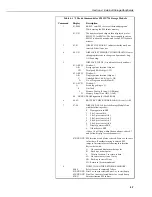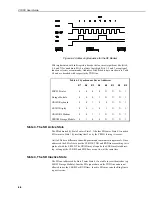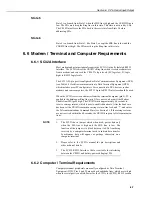
SECTION 5. TELECOMMUNICATIONS
5.1 TELECOMMUNICATIONS
COMMANDS
When a modem/terminal calls the CR10X, the
CR10X should answer almost immediately.
Several carriage returns (CR) must be sent to
the CR10X to allow it to set its baud rate to that
of the modem/terminal (300, 1200, 9600). Once
the baud rate is set, the CR10X sends back the
prompt ‘*’, signalling that it is ready to receive a
command.
General rules governing the telecommunications
commands are as follows:
1.
* from datalogger means ‘ready for
command’.
2.
All commands are of the form: [no.]letter,
where the number may or may not be
optional.
3.
Valid characters are the numbers 0-9, the
capital letters A-M, the colon (:), and the
carriage return (CR).
4.
An illegal character increments a counter
and zeros the command buffer, returning a
*.
5.
CR to datalogger means ‘execute’.
6.
CRLF from datalogger means ‘executing
command’.
7.
Any character besides a CR sent to the
datalogger with a legal command in its
buffer causes the datalogger to abort the
command sequence with CRLF* and to
zero the command buffer.
8.
All commands return a response code,
usually at least a checksum.
9.
The checksum includes all characters sent
by the datalogger since the last *,
including the echoed command sequence,
excluding only the checksum itself. The
checksum is formed by summing the
ASCII values, without parity, of the
transmitted characters. The largest
possible checksum value is 8191. Each
time 8191 is exceeded, the CR10X
restarts the count; e.g. if the sum of the
ASCII values is 8192, the checksum is 0.
10.
Commands that return Campbell Scientific
binary format data (i.e. the F and K
commands) return a signature (see
Appendix C).
The CR10X sends ASCII data with eight bits, no
parity, one start bit and one stop bit.
After the CR10X answers a call or completes a
command, it waits about 40 seconds (127
seconds in the Remote Keyboard State) for a
valid character to arrive. It drops out of
communications if it does not receive a valid
character in this time interval. Some modems are
quite noisy when not on line, and it is possible for
valid characters to appear in the noise pattern.
To ensure that this situation does not keep the
CR10X in telecommunications, the CR10X
counts all the invalid characters it receives from
the time it answers a ring, and terminates
communication after receiving 150 invalid
characters.
The CR10X continues to execute its
measurement and processing tasks while
servicing the telecommunication requests. If the
processing overhead is large (short execution
interval), the processing tasks will slow the
telecommunication functions. In a worst case
situation, the CR10X interrupts the processing
tasks to transmit a data point every 0.125
second.
The best way to become familiar with the
telecommunication commands is to try them from
a terminal connected to the CR10X via the
SC32A or other interface (see Section 6).
Commands used to interrogate the CR10X in the
telecommunications mode are described in the
following table.
5-2
















































